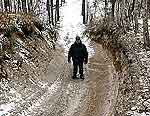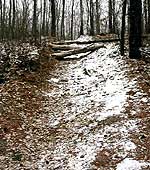By Tom Robertson
Minnesota Public Radio
March 12, 2002
Current state law lets users of all-terrain vehicles go almost anywhere they want in 46 of Minnesota's 58 state forests. That may not have been a big deal a few years ago. But in the past decade, the number of ATVs has nearly tripled, and the machines have caused widespread environmental damage. The DNR now says it wants to impose limits on ATV use, and the Legislature is also considering tighter ATV restrictions.
| |
|
|
|
||
In the Foothills State Forest in north central Minnesota, members of a local grass roots organization called the Jackpine Coalition are visiting the Spider Lake Recreation Area. On this day, it's quiet. But coalition member Richard Weiss says in the summer months, the woods are filled with the droning hum of hundreds of all terrain vehicles.
"It's a disaster is what it is. It's just a plain disaster," says Weiss. "I live, from right here, probably five miles away. I can step out of my house...and it just sounds like a great big mosquito out here. You hear them just tearing and ripping."
Locals aren't only concerned with noise. Since the DNR designated 26 miles of off-highway vehicle trails there three years ago, a haphazard web of new cross country trails has emerged. Riders of the powerful four-wheel drive vehicles have plowed through the forest. They've knocked down trees and brush and carved deep ruts in the soil. It's caused erosion on hillsides.
"You can see where they go right into the wetland," says Jackpine Coalition member Barry Babcock.
Babcock says the DNR has created a playground for ATV users. In fact, the Spider Lake Recreation Area has gained a national reputation. It's touted in OHV magazines as a wild area with little enforcement. Babcock says three people have been killed here in ATV mishaps in the three years since Spider Lake opened.
| |
|
|
|
||
"They call this their model - what they've done here - for the rest of their state forest planning. If this is their model, we're in trouble. Our state forests are in real serious trouble," Babcock says.
Farther up the trail is a DNR-approved obstacle course known as the challenge hill. On one side, the hill is covered with large rocks. It's a climbing wall for four-by-four trucks and jeeps. On the other side, a huge gouge, eight feet wide and 10 feet deep, rips down the hill. Richard Weiss says the damage almost brings tears to his eyes.
"They've made this. This is DNR money at work right here...see the roots exposed - the trees are going to die. Pretty soon this hill is going to be bare. It's all going to erode right down here, and right over here into this little pond...it's just not fair," says Weiss.
ATV rider organizations agree it's not fair. They say the problem is, they don't have enough places to ride. "Right now they have so few designated trails. Where are they going to go?" says All-Terrain Vehicle Association of Minnesota spokesman Dave Kryzer. "We're adding more regulation, but we're not providing the opportunity."
Officials with the DNR say ATVers have plenty of trails in most state forests, but they admit riders are largely uncontrolled there. And the DNR has so far not attempted to quantify the extent of the damage they've caused.
Dennis Asmussen, director of the DNR's trails and waterways division, says the agency has tried before to stop ATVs from traveling cross-country. But he says the agency was blocked by the legislature.
|
"The challenge for us is to find places for everyone - to find the kind of recreation they seek, and to try to keep them apart so the irritation level is as low as possible."
- Dennis Asmussen, DNR |
"In 1999, the DNR came to the Legislature with a proposal to effectively ban off-trail travel in all of the state forests. We were reversed on that," says Asmussen. "Since that time, we haven't had any authority to govern...off-trail travel in the 48 managed forests."
Some lawmakers at the time said they wouldn't support restrictions on ATVs until the DNR provides adequate trails on public lands for the estimated 200,000 ATV riders in Minnesota.
The DNR's answer was a plan to create a network of 1,500 miles of state forest trails, designated specifically for off-road use. That plan hit a snag in January, when a Cass County judge ruled the DNR must conduct environmental studies on proposed ATV trails. The DNR plans to appeal.
An organization called Minnesotans for Responsible Recreation led the suit against the DNR. MRR President Jamie Juenemann says most state forests are classified as managed. This means ATVs and other motor vehicles can travel on any roads or trails, unless they are posted closed.
Minnesotans for Responsible Recreation favors a limited classification, where motor vehicles can operate only on trails posted and designated open. Juenemann says that's the way neighboring states do it. He says the DNR is not protecting the state's natural resources.
"They haven't addressed the impacts nearly to the level that our surrounding states have," says Juenemann. "There's a belief, we think, within the agency, that they need to accomodate the needs of motorized recreation, particularly the ATV riders. And what they've done is essentially allowed them to do whatever they want on our public lands."
| |
|
|
|
||
Last week the DNR offered several new initiatives to control ATVs. Just days after the Star Tribune newspaper published a series of reports documenting ATV damage in state forests, the agency announced it would create a prototype area in Finland State Forest in northeastern Minnesota. The plan is to ban all cross country travel in the forest, and limit ATVs to designated trails only.
The DNR's Dennis Asmussen says he hopes the experiment will convince the Legislature to pass a law that would ban cross-ccountry travel in all state forests. He says that's been a goal of both environmentalists and ATV groups.
"The challenge for us is to find places for everyone - to find the kind of recreation they seek, and to try to keep them apart so the irritation level is as low as possible," says Asmussen.
There are some new efforts in the Legislature to ban cross-country ATV riding sooner rather than later. The proposed restriction is included as an amendment to an ATV funding bill passed by a House committee last week.
The proposed ban has the support of the All-Terrain Vehicle Association of Minnesota. Organization spokesman Dave Kryzer says association members aren't interested in cross country travel - just more ATV trails.
"We expect people to be driving on trails and not cross country, because the trails will be there for their use. There will be no need for cross country," says Kryzer.
The ATV Association and environmental groups agree that ATV users who damage state resources should be held accountable.
"What we need now is enforcement to come in and be part of this equation. Enforcement needs to be there to enforce the rules and regulations that currently exist," Kryzer says.
House and Senate versions of the ATV funding bill would provide $1.2 million to pay for three new conservation officers, who would work full time on ATV enforcement. The money would also be used to maintain ATV trails and study environmental impacts.
More from MPRMore Information



